When it comes to cosmetic surgical procedures, otoplasty is probably one that isn’t brought up very often. Otoplasty itself is the medical term used to describe a surgical procedure that is performed on the ear to alter, restore or enhance the appearance of the outer ear, or a procedure that is performed to repair damage that has been caused by some form of trauma or injury to the ear. The most commonly performed types of otoplasty are;
Ear Pinning – Ear pinning is a procedure that is used to correct the appearance of large of protruding ears that stick out from the side of the head. This form of otoplasty is performed to move the protrusion of the ears closer to the head to provide more balance and proportion to the head.
Lobuloplasty – Lobuloplasty Is the procedure that is designed to alter the size or shape of the earlobes or to address any abnormalities such as elongated or enlarged earlobes that have developed because of earrings, age or any defects such as injuries.
Revision Otoplasty – The revision otoplasty is performed to correct or further add to the results of a previously performed otoplasty surgery. Generally, revision otoplasty is minor in comparison to a standard otoplasty procedure and can often be performed under local anesthesia.
It doesn’t matter what the reason behind wanting to undergo otoplasty surgery is, the end goal is to achieve a balanced and proportionate appearance between the ears and the face, whilst maintaining a natural appearance.
Who is eligible to undergo otoplasty surgery?
As a procedure, otoplasty is able to be performed on both children and adults as the ears can be operated on at any point once they are fully developed. Generally, this means that from around age 5, if the ears require otoplasty surgery then a surgeon is likely to be able to perform the procedure. The reason why the ears need to be fully developed, or at least very close to fully developed, is that it will allows the surgeon to get a true picture of what is required and will allow them to properly assess what is needed to achieve balance and symmetry with the results.
Children are good candidates for otoplasty surgery as the cartilage in their ears is generally much softer and easier to shape. Otoplasty is actually becoming incredibly popular for children due to the impact that society and social influences can have on a child’s self confidence. By performing otoplasty surgery from as early as age 5, it can allow for any appearance issues to pre-emptively be corrected and can effectively prevent any negative interactions that could damage the self esteem of the child. This doesn’t mean that teenagers and adults won’t achieve results that are just as good however, it just means that the cartilage in the ear is a little more difficult to work with.
How should you prepare for otoplasty?
First things first, as with all surgical procedures, otoplasty patients will undergo an initial consultation to discuss the results that they are looking to achieve and what is going to happen during the procedure. This includes the evaluation of facial features (not just the ears) to create and develop a personalized plan of action that is purposely designed to help achieve the desired appearance for the patient.

How is ear surgery performed?
Generally, otoplasty is a completely safe and straightforward procedure that is performed as an outpatient procedure. This means that once the procedure is complete, the patient is safe to be discharged to go home once the surgery is complete. For children, the surgery is performed under general anesthetic but for adults, depending on the procedure, it’s possible that an otoplasty surgery can be performed under local anesthetic.
By using a range of techniques that are designed to minimize any visible scarring, the surgeon will make small incisions behind the ear or inside the natural folds. They will then perform the otoplasty procedure to alter the appearance of the ear, and once complete, will stitch the incisions up again. Any incisions made during the surgery typically heal very well and shouldn’t be able to be seen once healed.
What about after surgery?
After otoplasty surgery, the majority of patients experience some form of swelling, bruising and itchiness in the first few days. This is completely natural and can be managed with over the counter pain medication, but this shouldn’t be required after the first couple of days. You’ll leave the hospital with a special surgical bandage to cover the ears to reduce any risk of infection. After a few days, this can be removed and it may be advised to wear a soft headband while sleeping to protect the ears. If you sleep on your side, it is advised to sleep on your back for a few days post-surgery to let the ears heal.
When will my ears start to look normal again?
After the first week or so when the surgical bandages are removed, the ears are likely to be red and swollen. Over the coming days and weeks, these symptoms will subside until the final results are evident. The otoplasty procedure is considered to be completely permanent and the results should last a lifetime, although they may change over time due to the normal ageing process.

